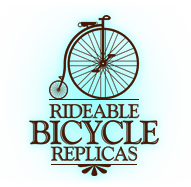
|
|
||
 |
 |
 |
 |
||||||||||||||||
|
Riding into his Future on the Wheels of the Past Greg Barron stopped keeping up with the latest fads and never looked back — a somewhat logical decision for a guy deriving most of his livelihood from something that went out with the stereopticon.
The penny-farthing, also known as a standard bicycle, ordinary or hiwheel, launched a worldwide craze. "Wheelmen," as riders were known, demanded such things as paved roads. And governments complied. Rubber became a vital commodity for the solid rubber tires. But by end of the 19th century, the hiwheel was on the skids, made obsolete by the new chain-driven "safety bike," that removes the rider from the teetering heights required to pilot a hiwheel. The "double triangle" frame of the safety bike is a design that's been tinkered with and gussied up for a century but basically remains unchanged. So how does a 43-year-old who started his career as an auto mechanic end up as a niche manufacturer of an object that went out of fashion a century ago? Family has something to do with it. "I've been riding these since I was 12," Barron said in an office punctuated by antique Brooks leather saddles and horns on the wall. His father, Mel Barron, bought what became Rideable Bicycle Replicas from a Cleveland Ohio man who launched the business a year earlier. According to Greg Barron, his father, who was no frame-builder at the time, figured the bikes would make a perfect gimmick for him as a bicycle distributor. Instead of handing out business cards at trade shows like everyone else, he'd have a product that would assure attention. Mel Barron attacked the hiwheel challenge like every other venture he took on in his life. "He'd say, how tough can it be?" the younger Barron recalls. "My father went into all of his businesses like that. He started his own magazine with no publishing experience. When he went into real estate and started working on houses, he'd say, 'How tough can it be? Here's a hammer. But what started as a sideline for his father's successful bicycle distribution business in the early '70s, became the only part of the business to survive. "The bike industry collapsed in 1977," Barron said. "[The market] went from 15 million a year sold to 3 million," he said. By the time the market recovered, manufacturers were already moving offshore, retailing shifted to toy, department and big box stores that handled distribution in-house, and the European bikes his father sold lost market share to Japanese made 10-speeds and then mountain bikes. Barron dumped the distribution and kept making the penny-farthings. To an outsider, "tough" doesn't come close. Barron and his crew do their own welding. Oh, and those front wheels about six feet in diameter? You can't buy them. You have to make them yourself. Same deal with the spokes. Same deal with the giant solid rubber tires. In the backyard workshop, wartime machinery whirrs into action. A flat strip of steel twice a man's height is fed into a drill press and Barron punches scores of holes. Next, the strip is loaded into another machine and, after several revolutions, it begins to acquire the unmistakable rounded shape of a wheel. Barron typically makes 75 to 150 of these bikes a year. In his worst year, he sold 45. His record was 300. But even with the dear price, penny-farthings are only one of this modern Alameda Renaissance-man's vocations. Along with the real estate, some financed through leveraged bike profits, Barron operates a diving adventure company where the fearless can have a close encounter with sharks from the relative safety of an undersea cage. He's also had some flops, like the pedal powered catamaran. As he shows off his collection of objects and models — he's successfully marketed hiwheels for department store displays and Disneyland — Barron's phone rings incessantly. In one ear a man on the line from Seattle is inquiring about an old GTO body in his yard (he deals in vintage cars, too); meanwhile, in the other ear, a man wants some work done on a hiwheel. In the other room Barron proudly displayed pictures of a Pontiac Fiero he transformed into a sail-powered car for the annual Burning Man festival. While he's not much afraid of competition — he feels it would cost too much for someone else to "tool up" their own operation when there's such a small market — Barron is someone who doesn't need lectures on diversification. For Barron, riding a hiwheel is a perfect metaphor for business. With no brakes, "You have to think 30 feet out in front of you," he says. - Contact Marc Albert at malbert@alamedasun.com Reprinted from an original article located at: |
||||||||||||||||||
 |
||||||||||||||||||
 |
 |
 |